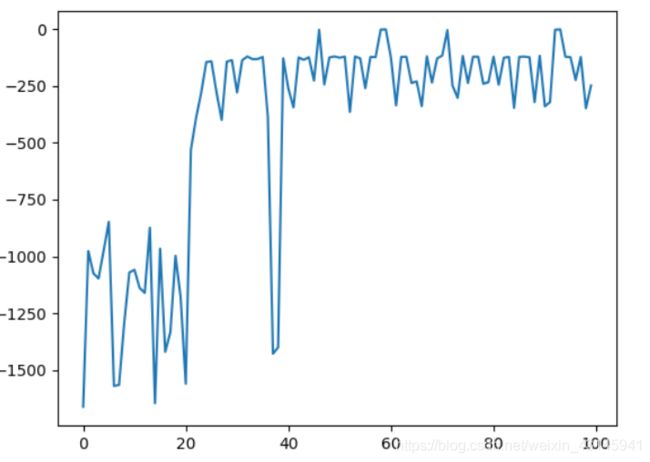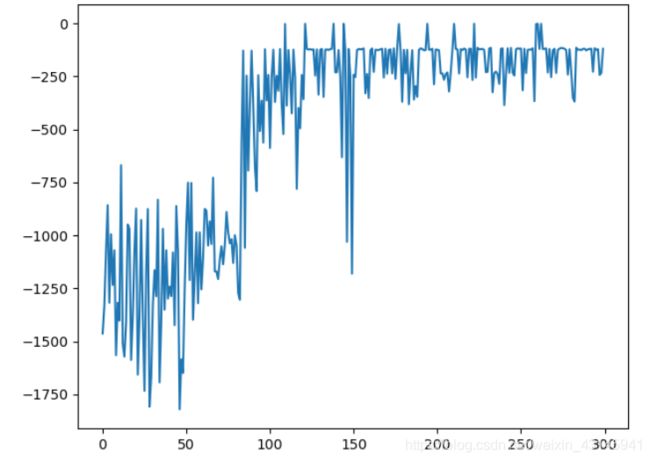深度强化学习DDPG算法高性能Pytorch代码(改写自spinningup,低环境依赖,低阅读障碍)
写在前面
- DRL各种算法在github上各处都是,例如莫凡的DRL代码、ElegantDRL(推荐,易读性NO.1)
- 很多代码不是原算法的最佳实现,在具体实现细节上也存在差异,不建议直接用在科研上。
- 这篇博客的代码改写自OpenAi spinningup源码DRL_OpenAI,代码性能方面不再是你需要考虑的问题了。
- 为什么改写?因为源码依赖环境过多,新手读起来很吃力,还有很多logger让人头疼。
- 这篇博客的代码将环境依赖降低到最小,并且摒弃了一些辅助功能,让代码更容易读懂。
- 如果本博客的代码在迁移至你的环境时依旧收敛不了,你的reward或者思路存在问题。
项目分三个文件:main.py , DDPGModel.py , core.py
Python3.6
DDPGModel.py
import numpy as np
from copy import deepcopy
from torch.optim import Adam
import torch
import core as core
class ReplayBuffer: # 输入为size;obs的维度(3,):这里在内部对其解运算成3;action的维度3
"""
A simple FIFO experience replay buffer for DDPG agents.
"""
def __init__(self, obs_dim, act_dim, size):
self.obs_buf = np.zeros(core.combined_shape(size, obs_dim), dtype=np.float32)
self.obs2_buf = np.zeros(core.combined_shape(size, obs_dim), dtype=np.float32)
self.act_buf = np.zeros(core.combined_shape(size, act_dim), dtype=np.float32)
self.rew_buf = np.zeros(size, dtype=np.float32)
self.done_buf = np.zeros(size, dtype=np.float32)
self.ptr, self.size, self.max_size = 0, 0, size
def store(self, obs, act, rew, next_obs, done):
self.obs_buf[self.ptr] = obs
self.obs2_buf[self.ptr] = next_obs
self.act_buf[self.ptr] = act
self.rew_buf[self.ptr] = rew
self.done_buf[self.ptr] = done
self.ptr = (self.ptr+1) % self.max_size
self.size = min(self.size+1, self.max_size)
def sample_batch(self, batch_size=32):
idxs = np.random.randint(0, self.size, size=batch_size)
batch = dict(obs=self.obs_buf[idxs],
obs2=self.obs2_buf[idxs],
act=self.act_buf[idxs],
rew=self.rew_buf[idxs],
done=self.done_buf[idxs])
return {k: torch.as_tensor(v, dtype=torch.float32) for k,v in batch.items()}
class DDPG:
def __init__(self, obs_dim, act_dim, act_bound, actor_critic=core.MLPActorCritic, seed=0,
replay_size=int(1e6), gamma=0.99, polyak=0.995, pi_lr=1e-3, q_lr=1e-3, act_noise=0.1):
self.obs_dim = obs_dim
self.act_dim = act_dim
self.act_bound = act_bound
self.gamma = gamma
self.polyak = polyak
self.act_noise = act_noise
torch.manual_seed(seed)
np.random.seed(seed)
self.ac = actor_critic(obs_dim, act_dim, act_limit = 2.0)
self.ac_targ = deepcopy(self.ac)
self.pi_optimizer = Adam(self.ac.pi.parameters(), lr=pi_lr)
self.q_optimizer = Adam(self.ac.q.parameters(), lr=q_lr)
for p in self.ac_targ.parameters():
p.requires_grad = False
self.replay_buffer = ReplayBuffer(obs_dim=obs_dim, act_dim=act_dim, size=replay_size)
def compute_loss_q(self, data): #返回(q网络loss, q网络输出的状态动作值即Q值)
o, a, r, o2, d = data['obs'], data['act'], data['rew'], data['obs2'], data['done']
q = self.ac.q(o,a)
# Bellman backup for Q function
with torch.no_grad():
q_pi_targ = self.ac_targ.q(o2, self.ac_targ.pi(o2))
backup = r + self.gamma * (1 - d) * q_pi_targ
# MSE loss against Bellman backup
loss_q = ((q - backup)**2).mean()
return loss_q # 这里的loss_q没加负号说明是最小化,很好理解,TD正是用函数逼近器去逼近backup,误差自然越小越好
def compute_loss_pi(self, data):
o = data['obs']
q_pi = self.ac.q(o, self.ac.pi(o))
return -q_pi.mean() # 这里的负号表明是最大化q_pi,即最大化在当前state策略做出的action的Q值
def update(self, data):
# First run one gradient descent step for Q.
self.q_optimizer.zero_grad()
loss_q = self.compute_loss_q(data)
loss_q.backward()
self.q_optimizer.step()
# Freeze Q-network so you don't waste computational effort
# computing gradients for it during the policy learning step.
for p in self.ac.q.parameters():
p.requires_grad = False
# Next run one gradient descent step for pi.
self.pi_optimizer.zero_grad()
loss_pi = self.compute_loss_pi(data)
loss_pi.backward()
self.pi_optimizer.step()
# Unfreeze Q-network so you can optimize it at next DDPG step.
for p in self.ac.q.parameters():
p.requires_grad = True
# Finally, update target networks by polyak averaging.
with torch.no_grad():
for p, p_targ in zip(self.ac.parameters(), self.ac_targ.parameters()):
# NB: We use an in-place operations "mul_", "add_" to update target
# params, as opposed to "mul" and "add", which would make new tensors.
p_targ.data.mul_(self.polyak)
p_targ.data.add_((1 - self.polyak) * p.data)
def get_action(self, o, noise_scale):
a = self.ac.act(torch.as_tensor(o, dtype=torch.float32))
a += noise_scale * np.random.randn(self.act_dim)
return np.clip(a, self.act_bound[0], self.act_bound[1])
core.py
import numpy as np
import scipy.signal
import torch
import torch.nn as nn
def combined_shape(length, shape=None): #返回一个元祖(x,y)
if shape is None:
return (length,)
return (length, shape) if np.isscalar(shape) else (length, *shape) # ()可以理解为元组构造函数,*号将shape多余维度去除
def mlp(sizes, activation, output_activation=nn.Identity):
layers = []
for j in range(len(sizes)-1):
act = activation if j < len(sizes)-2 else output_activation
layers += [nn.Linear(sizes[j], sizes[j+1]), act()]
return nn.Sequential(*layers)
def count_vars(module):
return sum([np.prod(p.shape) for p in module.parameters()])
class MLPActor(nn.Module):
def __init__(self, obs_dim, act_dim, hidden_sizes, activation, act_limit):
super().__init__()
pi_sizes = [obs_dim] + list(hidden_sizes) + [act_dim]
self.pi = mlp(pi_sizes, activation, nn.Tanh)
self.act_limit = act_limit
def forward(self, obs):
# Return output from network scaled to action space limits.
return self.act_limit * self.pi(obs)
class MLPQFunction(nn.Module):
def __init__(self, obs_dim, act_dim, hidden_sizes, activation):
super().__init__()
self.q = mlp([obs_dim + act_dim] + list(hidden_sizes) + [1], activation)
def forward(self, obs, act):
q = self.q(torch.cat([obs, act], dim=-1))
return torch.squeeze(q, -1) # Critical to ensure q has right shape.
class MLPActorCritic(nn.Module):
def __init__(self, obs_dim, act_dim, hidden_sizes=(256,256),
activation=nn.ReLU, act_limit = 2.0):
super().__init__()
# build policy and value functions
self.pi = MLPActor(obs_dim, act_dim, hidden_sizes, activation, act_limit)
self.q = MLPQFunction(obs_dim, act_dim, hidden_sizes, activation)
def act(self, obs):
with torch.no_grad():
return self.pi(obs).numpy()
main.py
from DDPGModel import *
import gym
import matplotlib.pyplot as plt
if __name__ == '__main__':
env = gym.make('Pendulum-v0')
obs_dim = env.observation_space.shape[0]
act_dim = env.action_space.shape[0]
act_bound = [-env.action_space.high[0], env.action_space.high[0]]
ddpg = DDPG(obs_dim, act_dim, act_bound)
MAX_EPISODE = 100
MAX_STEP = 500
update_every = 50
batch_size = 100
rewardList = []
for episode in range(MAX_EPISODE):
o = env.reset()
ep_reward = 0
for j in range(MAX_STEP):
if episode > 20:
a = ddpg.get_action(o, ddpg.act_noise)
else:
a = env.action_space.sample()
o2, r, d, _ = env.step(a)
ddpg.replay_buffer.store(o, a, r, o2, d)
if episode >= 10 and j % update_every == 0:
for _ in range(update_every):
batch = ddpg.replay_buffer.sample_batch(batch_size)
ddpg.update(data=batch)
o = o2
ep_reward += r
if d:
break
print('Episode:', episode, 'Reward:%i' % int(ep_reward))
rewardList.append(ep_reward)
plt.figure()
plt.plot(np.arange(len(rewardList)),rewardList)
plt.show()
对比
我拿了一个github上写得比较好的Soft-AC算法来和本博客的DDPG算法进行相同环境(倒立摆)比较,reward curve如下:


第一张图是本博客DDPG算法,第二张是github上softAC算法,注意看横轴,本博客在20个回合后就收敛了,softAC在第90个回合才逐步收敛。并且:softAC是比DDPG更加先进的算法,先进的算法都差这么多,由此可以看出本博客代码的性能优势。
why
spinningup代码看下来之所以性能高可能在两个方面:
- 网络架构好
- 训练方式:前期直接sample动作范围内一个值,这样极大丰富了replay_buffer的信息量,之后才开始更新网络。
- 参数的选择以及一些细节trick(冻结参数这种操作等)